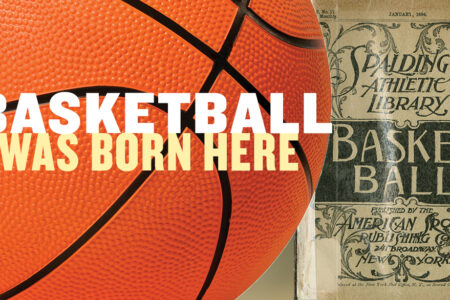Three-Point Field Goal Celebrates 30th Anniversary
Former Springfield College Athletic Director Ed Steitz led way for rule that changed college game forever
Former Springfield College Athletic Director Ed Steitz led way for rule that changed college game forever
Former Springfield College Athletic Director Ed Steitz led way for rule that changed college game forever
It is perhaps the most famous backyard basketball court in America. It sits behind a well-maintained home in East Longmeadow, Mass., where the late Springfield College Athletic Director Ed Steitz, G’48, DPE’63, once resided.
Steitz was the secretary rules editor of the NCAA Men’s Basketball Committee when the three-point field goal was officially introduced 30 years ago for the start of the 1986-87 season.
His oldest son, Steve ’73, now lives in the house that is located just a few miles from where basketball was invented by Dr. James Naismith at the International YMCA Training School (now Springfield College) 125 years ago.
The court still looks the way it did in the summer of 1973 when the elder Steitz enlisted his youngest son Bob ’80, G’81, and some friends to help gather data for a new rule that would change the college game forever.
Steitz would have the kids shoot jumpers at various points from beyond the foul line and write down the number of makes and misses each person compiled when guarded and unguarded.
“My father told us at some point the game would need a three-point shot and we had no idea what he was talking about,” Bob Steitz recalled in a recent phone interview. “We thought it was a joke at first, but then it became serious.
“Then, it was just putting down some markings and etchings on the court and measuring things out. The foul line is 15 feet obviously and how far you need to go back. The other piece was that he knew at the end of the games, it was going to be an important part for teams to get back into a game, and it was also important to have the right people shooting the shot because percentages would dictate that if you always had your best shooters out there your team percentage was probably going to be pretty good.
“Sometimes you would have guys shooting the shot that wasn’t their forte and that’s where the percentages pretty much balanced out to where he thought they should be, and I think, at the time, it was between 36 and 38 percent. He always used the line that you had to be very careful with any rule change, that you don’t disrupt the delicate balance between offense and defense,” Bob Steitz noted.
Three-point field goal makes debut
Several conferences used the three-point field goal on an experimental basis (with varying distances) prior to the NCAA Rules Committee (which included Division II and III members) passing the legislation in time for the 1986-87 season.
The first official game with the three-pointer set at 19 feet, 9 inches (it was moved to 20’9” in 2008) took place on Nov. 22, 1986, when North Carolina State (NCSU) defeated Navy 86-84 in the Tip-Off Classic at the Springfield (Mass.) Civic Center.
Forward Bennie Bolton led the Wolfpack with 20 points and connected on the first three-pointer just 2:59 into the game. He finished with four treys, as did Kenny Drummond who netted 18 points, including a winning three with 14 seconds remaining that accounted for the game’s final points.
Springfield native Vinny Del Negro contributed 19 points in 17 minutes coming off the bench, including a pair of three-pointers as NCSU made 10-of-20 of the long distance shots.
Navy had more field goals (33 to 32) and free throws (15 to 12), but finished with only three three-pointers in four attempts (all by Doug Wojcik). David Robinson had a double-double with 36 points and 10 rebounds before fouling out late in the game.
“As you guys can see, the three-point rule makes a difference,” Navy coach Pete Herrmann said after the game.
“Robinson’s the reason we went outside,” stated NCSU coach Jim Valvano. “And we were living and dying with the outside shot. I don’t like it, but we’ll take it because these kids can knock them in.”
Many of Valvano’s colleagues didn’t like the new rule either. Steitz, especially, received a tremendous amount of criticism. By the end of the season, however, the approval rate rose to a whopping 80 percent after two-thirds of the nation’s coaches were against it a year earlier.
New rule helps Indiana win national title
The 1987 NCAA Championship between Indiana and Syracuse may have had something to do with it.
Steve Alford, a 6’2” guard, netted a game high 23 points that included seven of 10 attempts from beyond the arc, as the Hoosiers captured their fifth NCAA crown with a thrilling 74-73 victory before 64,959 fans at the Superdome in New Orleans. Keith Smart’s jumper in the final seconds gave Coach Bob Knight his third national title.
“I sit here and look at the box score and the thing that I like least of all in basketball is the three-point shot, and we make three more points from the three-point shot than Syracuse does, and that’s the difference in the game. So, uh, thanks Ed,” Knight said in the post-game press conference.
It’s worth noting that Knight appreciated the hard work Steitz put into the game. Knight gave him the nickname “The Father of the Three-Point Field Goal” and both were good friends for many years before the three-pointer and right up until Steitz’s death in 1990.
Ironically, Indiana shot 50.8 percent from three-point territory during the 1986-87 season, a record that still stands for Division I programs.
And who will ever forget Villanova’s 77-74 victory over North Carolina in last year’s NCAA title game before 74,340 at NRG Stadium in Houston, Texas?
The Tar Heels’ Marcus Paige made an off-balance three-pointer to tie the score with 4.7 seconds remaining. After a timeout, Kris Jenkins raced up court, took a pass from Ryan Arcidiacono and connected on a three at the buzzer to give the Wildcats their second NCAA title and first since 1985.
Incredibly, North Carolina (11 for 17) and Villanova (8 for 14) combined to make 19 of 31 three-pointers (61.3 percent).
Strong hunch paid off
Steitz knew all along the three-pointer would have a tremendous impact on the game. He had the foresight and facts to realize the rule could be a real game-changer.
As a former coach, Steitz felt it was time to open the game up from players who were dominating the middle. He was quoted many times saying, “It’s going to force teams to play more defense away from the basket. People will say, ‘You’re putting the little man back in the game,’ and that’s good.”
Steitz also believed the rule made coaches more creative in devising strategies to defend the three-pointer.
“It’s going to force teams to play more defense away from the basket. People will say, ‘You’re putting the little man back in the game,’ and that’s good.”
Ed Steitz, former Springfield College Athletic Director and NCAA basketball rules editor
Steitz was involved with several other significant rule changes during his career, including the 45-second shot clock in 1985, the elimination of the jump ball except at the start of the game in 1981, and the return of the dunk in 1976.
But it was the three-point field goal of which he was the most proud. He once said, “The dunk is no longer basketball’s home run, the three-point shot is.”
Tremendous passion for game
The Beacon, N.Y., native and Cornell graduate (where he was an All-Ivy League baseball selection) came to Springfield in 1948 and served as the school’s athletic director for 33 years. As men’s basketball coach, Steitz compiled a 160-86 record (65.0 percent) from 1956-66. During a two-month world tour in 1965, his team won all 25 games and conducted more than 100 clinics in 10 nations.
Steitz succeeded John Bunn (another former Springfield coach) as NCAA secretary rules editor in 1965 and held the position for more than a quarter of a century. Ed Bilik ’57, G’62, who played for both Bunn and Steitz and later coached men’s basketball and served as athletic director at Springfield, was the rules editor from 1997 through 2010.
“Ed was very dedicated and devoted to everything he did to help basketball and Springfield College. He was always analyzing things and coming up with thoughtful procedures that made him very productive,” said Bilik.
Many agree that Steitz was a basketball visionary and one of the game’s greatest ambassadors. He was inducted into the Naismith Memorial Basketball Hall of Fame in 1984 and the Federation of International Basketball Associations (FIBA) Hall of Fame in 2007.
“Ed had a great passion and love for the game, and his knowledge of the rules was impeccable,” said basketball broadcaster and hall of famer Dick Vitale. “He would do anything to make the game better, always researching, studying, and analyzing things. Ed loved what he was doing—he was special!”
Steitz died at the age of 69 on May 21, 1990, a day after serving as the grand marshal at the Springfield College commencement. Strains of the Harlem Globetrotters theme song “Sweet Georgia Brown” played at his memorial in the College’s Blake Arena.
As Bob Steitz told Dana O’Neil of ESPN.com in an article in 2011, “I think my dad would be pleased but not surprised [by the success of the three-pointer]. He really believed it would work.”
Today’s generation of players has grown up with the three-point shot, and with numerous games on TV, crowd-pleasing buzzer beaters have added greatly to the excitement of the game on all levels. Many seem to occur in the NCAA Tournament.
That’s exactly what Steitz was thinking about when he had his son and his East Longmeadow pals shooting basket after basket on a backyard court that is now a piece of the sport’s history.
(The NBA adopted the three-point shot starting in the 1979-80 season, while NCAA women’s basketball teams began shooting three-pointers in 1987-88.)
Ken Cerino served as the sports information director at Springfield College from 1986-2000.




